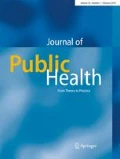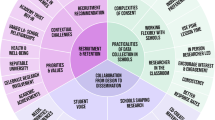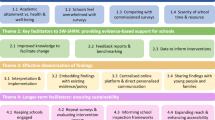Abstract
Cross-national surveys have the potential to make a significant contribution to the study of adolescent health. The Health Behaviour in School-aged Children (HBSC) study was among the first international studies established in three countries in 1983 and growing to more than 40 countries for the seventh wave of fieldwork in 2005/06. The original aim of the study has remained largely the same since its inception, to increase understanding of adolescent health behaviours, health and well being in their social context and to collect high quality comparable data to achieve this. The challenges to producing valid and reliable data from cross-national, school-based research were recognised from the outset and reflected in the methodological development of the study. The paper sets out how these challenges were addressed, examining key aspects of the methodology, including study design, questionnaire content, data collection and file preparation. These methods are still in place, but HBSC has had to recognise the social and political change of recent years. The challenges that were recognised 20 years ago are magnified today, with the study embracing a variety of cultures across Europe and North America. As demand for HBSC data has grown from the scientific and policy communities, greater attention has been paid to scrutiny of the data produced, matched by a sharper focus on continuous improvement in data quality. Key developments of recent years are summarised in the paper, focusing on study organisation, review of the international Research Protocol, strengthening support for sampling, greater attention to translation and improvements in data processing and documentation. It is concluded that the HBSC study has evolved over the last 20 years and continues to do so, recognising the importance of data quality, but also the constraints of cross-national survey research. Looking to the future, some outstanding issues for consideration are touched upon, including the opportunities and challenges for expanding our knowledge on the possibilities for gathering cross-national and cross-cultural data, with the HBSC study being used to build capacity in understanding the health needs of young people in other regions of the world.
Similar content being viewed by others
References
Aarø LE, Wold B, Kannas L, Rimpelä M (1986) Health behaviour in school-children. A WHO cross-national survey. Health Promot 1:17–33
Association of Public Health Observatories (2006) Indications of public health in the English regions. 5: Child health. Association of Public Health Observatories
Boyce W, Torsheim T, Currie C, Zambon A (2006) The family affluence scale as a measure of national wealth: validation of an adolescent self-reported measure. Soc Indic Res 78:473–487. DOI 10.1007/s11205-005-1607-6
Bradshaw J, Hoelscher P, Richardson D (2007) An index of child well-being in the European Union. Social Indicators Research 80:133–177.DOI 10.1007/s11205-006-9024-z
Currie C, Hurrelmann K, Settertobulte W, Smith R, Todd J (eds) (2000) Health and health behaviour among young people. Health Behaviour in School-aged Children: a WHO cross-national study (HBSC) international report. WHO Policy Series: Health policy for children and adolescents, issue 1. WHO Regional Office for Europe, Copenhagen
Currie C, Samdal O, Boyce W, Smith R (2001) Health Behaviour in School-aged Children: a WHO cross-national study. Research protocol for the 2001/2002 Survey. University of Edinburgh, Edinburgh
Currie C, Roberts C, Morgan A, Smith R, Settertobulte W, Samdal O, Barnekow-Rasmussen V (eds) (2004) Young people’s health in context. Health Behaviour in School-aged Children (HBSC) study: international report from the 2001/2002 survey. Health policy for children and adolescents, no. 4. WHO Regional Office for Europe, Copenhagen
Economic and Social Research Council (2006) Specification for survey design and measurement: an ESRC research initiative. ESRC, Swindon
Elgar F, Moore L, Roberts C, Tudor-Smith C (2005) Validity of self-reported height and weight and predictors of bias in adolescents. J Adolesc Health 37:371–375. DOI 10.1016/j.jadohealth.2004.07.014
European Commission (2000) Report on the state of young people’s health in the European Union. A Commission Services working paper. Directorate General Health and Consumer Protection. European Commission, Brussels
European Science Foundation (1999) The European Social Survey (ESS)–A research instrument for the social sciences in Europe. European Science Foundation, Strasbourg
Gonçalves A, Matos MG, Marques FV, Gaspar T, Faustino M, Rosabal M, Moniz JC, Torgal J (2005) A saúde e estilo de vida dos Adolescentes Cabo-verdianos frequentando e ensino secundário [The Health and Lifestyle of Cabo Verde Adolescents]. Lisboa: Instituto de Higiene e Medicina Tropical, Universidade Nova de Lisboa [Institute of Hygience & Tropical Medicine, New University of Lisbon]
Harkness J (1999) In pursuit of quality: issues for cross-national survey. Research. Int J Soc Res Methodol 2:125–140. DOI 10.1080/136455799295096
Harkness JA (2003) Questionnaire translation. In: Harkness JA, Van De Vijver FJR, Mohler P (eds) Cross-cultural survey methods. Wiley Series in Survey Methodology, Hoboken, New Jersey
Haugland S, Wold B (2001) Subjective health in adolescence-Reliability and validity of the HBSC symptom check list. J Adolesc 24:611–624
King A, Wold B, Tudor-Smith C, Harel Y (1996) The health of youth. A cross-national survey. A report of the 1993–94 survey results of Health Behaviour in School-Aged Children: a WHO cross-national study. WHO regional publications. European Series No. 69. WHO Regional Office for Europe, Copenhagen
Kish L (1994) Multipopulation survey designs: five types with seven shared aspects. Int Stat Rev 62:167–186
Levy PS, Lemeshow S (1999) Sampling of Populations. Methods and Applications. Wiley, New York
Leyland A, Goldstein H (eds) (2001) Multilevel modelling of health statistics. Wiley, New York
Lynn P (2003) Developing quality standards for cross-national survey research: five approaches. Int J Soc Res Methodol 6:323–336. DOI 10.1080/13645570210132848
Phongsavan P, Olatunbosun-Alakija A, Havea D, Bauman A, Smith BJ, Galea G, Chen J and Members of the Health Behaviour and Lifestyle of Pacific Youth Survey Collaborating Group and core survey teams (2005) Health behaviour and lifestyle of Pacific youth surveys: a resource for capacity building. Health Promot Int 20:238–248. DOI 10.1093/heapro/dah612
Practical exemplars and survey analysis (PEAS) web resource. http://www.napier.ac.uk/depts/fhls/peas/about.asp. Accessed 28th February 2007
SAS Institute Inc (2004) SAS/STAT 9.1 User’s Guide. SAS Institute Inc, Cary, NC
Smet B, Maes L, De Clercq L, Haryanti K, Djati Winaro R (1999) The Health Behavior in School-Aged Children study in Semarong, Indonesia: methodological problems in cross-cultural research. Health Promot Int 14:7–16
Smith C, Wold B, Moore L (1992) Health behaviour research with adolescents: a perspective from the WHO cross-national Health Behaviour in School-aged Children study. Health Promotion Journal of Australia 2:41–44
SPSS Inc. (2006) SPSS 15.0. SPSS Inc, Chicago
StataCorp. (2005) Stata statistical software: release 9.0. Stata Corporation, College Station, TX
Torsheim T, Wold B, Samdal O (2000) The teacher and classmate support scale: factor structure, test-retest reliability and validity in samples of 13- and 15 year old adolescents. Sch Psychol Int 21:195–212
UNICEF (2004) Economic growth and child poverty in the CEE/CIS and the Baltic states. Innocenti Social Monitor 2004. UNICEF, Innocenti Research Centre, Florence
UNICEF (2007) Child poverty in perspective: an overview of child well-being in rich countries. A comprehensive assessment of the lives and well-being of children and adolescents in the economically advanced nations. Innocenti Research Centre Report Card 7. UNICEF, Innocenti Research Centre, Florence
Vereecken C, Maes LA (2003) A Belgian study on the reliability and relative validity of the Health Behaviour in School-Aged Children food frequency questionnaire. Public Health Nutr 6:581–588. DOI 10.1079/PHN2003466
World Health Organization (2006) Addressing the socio-economic determinants of healthy eating habits and physical activity levels among adolescents. WHO Regional Office for Europe, Copenhagen
Acknowledgements
The authors would like to acknowledge principal investigators of the HBSC International Research Network: Dr. Wolfgang Dür, University of Vienna, Austria; Prof Lea Maes, University of Gent, Belgium; Dr Danielle Piette, Université Libre de Bruxelles, Belgium; Dr Lidiya Vasileva, Bulgarian Academy of Sciences, Bulgaria; Dr Will Boyce, Queen’s University, Canada; Dr Marina Kuzman, Croatian National Institute of Public Health, Croatia; Dr Ladislav Csémy, Prague Psychiatric Centre, Czech Republic; Associate Prof Pernille Due, University of Copenhagen, Denmark; Mr Antony Morgan, National Institute for Health and Clinical Excellence (NICE), England; Dr Katrin Aasvee, National Institute for Health Development, Estonia; Dr Jorma Tynjälä, University of Jyväskylä, Finland; Dr Emmanuelle Godeau, Service médical du Rectorat de Toulouse, France; Prof Klaus Hurrelmann, University of Bielefeld, Germany; Associate Prof Anna Kokkevi, University Mental Health Research Institute (UMHRI), Greece; Dr Birgit Niclasen, Lægeklinikken (District Medical Centre), Greenland; Dr Ágnes Németh, National Institute of Child Health, Hungary; Dr Thoroddur Bjarnason, University of Akureyri, Iceland; Dr Saoirse Nic Gabhainn, National University of Ireland, Republic of Ireland; Dr Yossi Harel, Bar-Ilan University, Israel; Prof Franco Cavallo, Universita degli Studi di Torino, Italy; Dr. Iveta Pudule, Health Promotion State Agency, Latvia; Dr Apolinaras Zaborskis, Kaunas University of Medicine, Lithuania; Dr Yolande Wagener, Ministère de la Santé, Luxembourg ; Ms Lina Kostarova Unkovska, Center for Psychosocial and Crises Action (CPCA), tfyr Macedonia; Ms Marianne Massa, Health Promotion Department, MALTA; Prof Wilma A.M. Vollebergh, the Netherlands Institute of Mental Health and Addiction, the Netherlands; Dr Oddrun Samdal, University of Bergen, Norway; Dr Joanna Mazur, Mother and Child National Research Institute, Poland; Dr Margarida Gaspar de Matos, Universidade Tecnica de Lisboa, Portugal; Prof. Adriana Baban, Babes-Bolyai University, Romania; Dr Alexander Komkov, SPb Research Institute of Physical Culture, Russia; Prof Candace Currie, University of Edinburgh, Scotland; Dr Elena Morvicová, Public Health Authority of the Slovak Republic, Slovak Republic; Ms Helena Jericek, Institute of Public Health of the Republic of Slovenia, Slovenia; Dr Carmen Moreno Rodriguez, University of Seville, Spain; Dr Ulla Marklund, National Institute of Public Health, Sweden; Dr Holger Schmid, Swiss Institute for the Prevention of Alcohol and Drug problems, Switzerland; Prof Oya Ercan, Istanbul University, Turkey; Dr. Ron Ianotti, National Institute of Child Health and Human Development, USA; Dr Olga Balakireva, Ukranian Institute for Social Research, Ukraine; Mr Chris Roberts, Welsh Assembly Government, Wales.
Conflict of interest statement
There are no relevant associations that might pose a conflict of interest.
Author information
Authors and Affiliations
Corresponding author
Rights and permissions
About this article
Cite this article
Roberts, C., Currie, C., Samdal, O. et al. Measuring the health and health behaviours of adolescents through cross-national survey research: recent developments in the Health Behaviour in School-aged Children (HBSC) study. J Public Health 15, 179–186 (2007). https://doi.org/10.1007/s10389-007-0100-x
Received:
Accepted:
Published:
Issue Date:
DOI: https://doi.org/10.1007/s10389-007-0100-x




